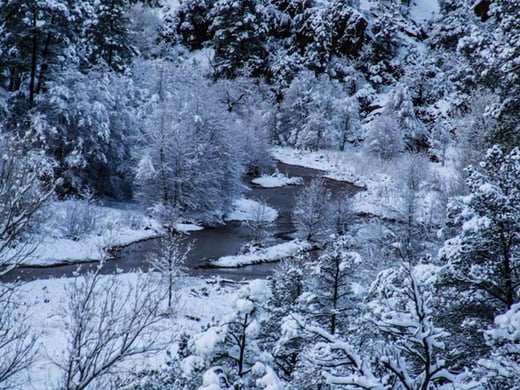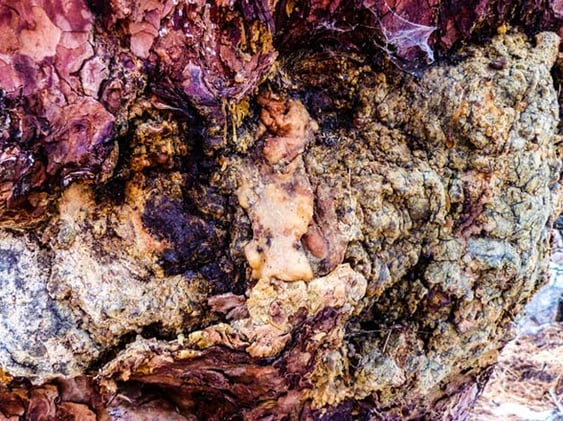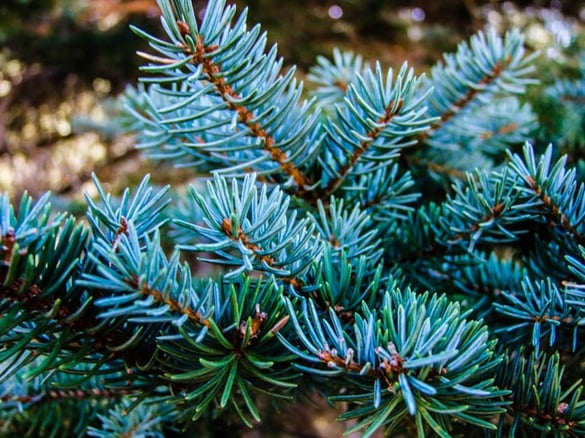Our winter post from Kiva Rose Hardin is here and it'll make you swoon. Her beautifully written articles marry the personal with the scientific, lore with experience, offering untamed and fresh insight. Herbalist, wildcrafter, artist, and storyteller, Kiva Rose lives in a canyon botanical sanctuary within the Gila Wilderness of New Mexico. She is also the co-director of the Herbal Resurgence Rendezvous, held each September in the mountain Southwest, coeditor of Plant Healer Magazine, and publisher of the just released historical novel, The Medicine Bear by Jesse Wolf Hardin, and maintains an herbal blog, The Medicine Woman’s Roots.
Living in the coniferous forests of the mountain Southwest, Winter here is evergreen even at twenty below and when covered in snow. The towering Ponderosa Pines and Douglas Firs are a constant reminder to me of the particular kind of intimacy one can foster with the plants during the cold moons. Standing up to my knees in snow with my face pressed against the soft gray bark of a Southwestern White Pine, I can smell the wild flare of spice and earth that lingers beneath the damp chill of the air. These moments spent immersed in the hush of ice-tipped twigs and frozen earth teach me about another layer of the forest, one that can only be learned in this season and place.
While Spring is generally the optimal time to gather the new green tips of conifers, even during the darkest days of Winter the needles and bark impart a lovely flavor to food and beverages. Winter is also an excellent time to gather resin, especially after storms that can often knock large chunks of this aromatic substance to the ground. This makes it much easier to gather, although I have certainly been known to shimmy up many a Pine to reach a choice chunk of resin. It also lessens the chance of us accidentally harming the tree by ripping resin directly off a tree wound.
Recognizing Resin
First, let’s explore what conifer resin even is. In my years teaching about plants and their parts, I have noticed a common tendency to mislabel resins as sap, pitch, gums, latex, and various other terms. Many people call the amber colored resin exuded on the trunks of Pine trees “sap,” but this is incorrect. In fact, sap is a fluid held that transports nutrients through the body of a tree. Sap can be cooked down to create syrups, as with Birch, Maple, and Fir. However, the substance we refer to here is specifically resin, a viscous fluid that can become solid as it ages. It’s much more frequently found in some conifer species than others, but it’s not uncommon to see golf ball sized pieces of resin at the base of Piñon Pines here in the mountains of New Mexico. In some cases, the resin will still be liquid and very sticky, dripping in thick caramel colored streams down a branch or the body of a tree, sometimes near an obvious wound or missing pieces of bark. This resin can certainly still be collected, but is messier than the solid or semi-solid chunks.
All members of Pine family contain resins in their leaves, but some genera only produce resin on the body of the tree when exposed to trauma and injury. Other conifers are more mixed, and will require you getting out to your local evergreen forests to see what trees live there, and which produce enough resin to gather. I harvest much of my resin from various Pine species, but also from some Spruce and Fir species. These conifers are also a great starting place for learning tree identification. Many folks can feel intimidated by this process, but conifers tend to have fairly simple characteristics to help differentiate one genus from another. Even a quick search online can bring up websites showing the basic needle/leaf and cone differences of the primary conifer types.
Resin has long been known as an herbal remedy, perfume, incense and much more, but perhaps the most well known resin is the fossilized form known as amber. Often called a stone, this beautiful substance is actually the selfsame medicine we speak of here, though much older than what we will be harvesting from our forests.
Tips for Harvesting
When harvesting, it’s important to realize that resin circulates through the body of conifers, and helps to seal off any injury to the tree from insect infestation or microbial invasion. Thus, in order to avoid further harm to a tree, we need to be careful to harvest resin where it has dripped down the body of the tree or fallen on the ground, rather than harvesting directly from the wound. Trees have been historically tapped for resin, and some still are. It’s only possible to keep from killing the tree while doing this, in the case of certain species, if done very carefully.
While there may be more specialized methods, I've always just gathered my resin with my hands, a knife, and parchment paper lined container, sometimes with the aid of a couple strong twigs. If the resin is solid or semi-solid, it’s pretty simply to just pick it up off the ground, cut it carefully from the bark, or coax softer pieces off with a twig or two used in a chopstick like manner. If the chunks are very tiny, as can be the case with some Spruce trees, fingertips and a small knife can be used to coax the dried droplets of resin from the bark into your container, always being careful to leave enough to protect the tree. If the resin is still in an entirely liquid state, harvesting can be more of a challenge. Because it’s relatively easy to find large chunks of resin here, I rarely resort to collecting the liquid resin, but it is certainly possible. With a stainless steel scraper, similar to what is sometimes use in baking, and a twig, I’ll use the twig to help push the resin onto the scraper. Again, it’s also possible to tap a tree for resin, but it’s much more likely to hurt the tree and should not be attempted without a more complete understanding of the process, hopefully with training from someone experienced in a non-harmful technique.
This hands-on approach can leave your hands a delicious smelling but sticky mess! As noted above, resins are lipid soluble, and can thus be cleaned off using most oils including olive oil, washing with soap water afterwards. Since resin is also alcohol soluble, you can use vodka or other spirits in the same way, although you may find this drying to your skin, especially in Winter.
You may want to keep a set of harvesting and processing tools on hand just for working with resin. It’s possible to clean up most any resin mess with oil and alcohol, but it can be very time consuming. If you also work with other resins such as propolis, it can be even more challenging. Personally, I have a stainless steel bowl I keep just for collecting resin and mixing kyphi style incense in, as well as stainless steel mixing and measuring tools for working the resin.
Other Uses
Incense
The harder grades of resin make a wonderful copal type incense all on their own, and can be burned over charcoal or on a metal plate on top of a wood stove or similar. These are strong and concentrated scents, so start with a small dusting of crumbled resin and build up to the fragrance intensity you prefer. You may want to read my previous post on incense called Plant Devotions in Smoke for more on crafting bioregional incense from your local conifer resins. http://bearmedicineherbals.com/incense.html
Tincture
Resin is also somewhat alcohol soluble and can be tinctured. However, be aware that is not water soluble and so low proof alcohol is not an especially efficient method of extraction. 95% alcohol is preferred for this use, and will extract as much of the resin as is possible. Consider resin a dried plant for the purpose of tincturing, and use an approximately 1:5 weight to volume proportion, or you can just eyeball it and throw in about one quarter to one third of a jar full of resin, and then pour the alcohol on top.
Small amounts of a resin tincture can add a distinctive flavor to foods such as shortbread. It can also be used in mouth washes similar to myrrh. Resin is distinctly expectorant and I sometimes use a small proportion of resin tincture in my cough formulae. Remember that resin is strong medicine, so start with low doses and adjust according to your experience. If you've worked with myrrh tincture previously, you’ll find that many conifer resins can be dosed and used similarly.
Perfume Base
Resin infused into a high quality oil, such a jojoba, can be a gorgeous base for a solid perfume. Likewise, a high proof alcohol tincture of a conifer resin is wonderful base for building perfumes. Not only do the resins add a deep, forest note to the perfume, they also seem to prolong the longevity of the perfume overall. This is especially complimentary to amber and woodsy aromatic formulae.
Evergreen Infused Oil, Creams, and Salves
As previously mentioned, resin is fat soluble, and thus, can be effectively infused into an oil. Using any basic infused oil recipe, we can first add the resin to a glass container with an air tight lid. If the resin is entirely solid, you can grind or smash it into smaller pieces, or right down to a powder. If it’s softer, you can freeze it first and break it down from there, or just transfer the sticky mess to the jar, as it will all dissolve.
From there, I prefer to place my container in a warm, dark place for several weeks. I prefer a warm method infused oil, and so often stick my jars of resin and oil into the woodstove warmer, taking out to shake periodically. I have other friends who use a crockpot (usually one dedicated to herbal preparation) on low for this purpose, but as I have very limited electricity in our wilderness sanctuary, I tend to stick with my woodstove. Sometimes all of the resin will dissolve into the oil, and other times there may be a sticky layer on the bottom of the container. If there are no bark or leaf bits floating in the oil, we can simply pour it off into a new container. If there is other plant matter in there, then it can be more desirable to strain the oil through a fine sieve or something similar.
This aromatic oil can be used as is, or included as an ingredient in a salve or cream. Creams, lotions, and body butters made with conifer resins tend to be sensually forest scented and wonderfully warming, making it a perfect Winter indulgence for the skin. The oil can also be included in warming massage oil blends.
Making Your Own Forest Balsam
This simple salve not only provides an instant fragrant fix of the wildwood wherever you are, it’s also a wonderful warming balm for old injuries, wounds that won’t heal, and sore, aching muscles and joints. It also makes a lovely first aid salve for any number of scratches, bruises, and abrasions, and can help heal cracked feet and hands during the Winter months, especially if a moistening herb such as comfrey or a bit of lanolin is added to the blend.
Here in southwestern New Mexico, many people think of Pine resin salve primarily as a treatment for pulling out splinters, embedded glass, drawing out boils, and for general first aid. It’s so common that it’s often sold in gas stations, and most any local logger or farm worker knows about it. You can just apply straight up soft resin to the afflicted area, but that can be messy, so I tend to prefer the salve, especially for deeply embedded objects that will likely take several days or more of application before results are seen. Because the resin is a counterirritant that stimulates blood flow and local immune response, the area may look more inflamed initially, but in general, this is a good sign and shows that the salve is working.
All in all, this is a very multipurpose remedy, and I would keep it in stock just for the aromatherapeutic properties even if it didn’t have so many other uses. Many folks find the scent of Forest Balsams to be very uplifting and anxiety relieving. I have a number of clients who carry it with them all the time, just to sniff or apply to their hands when they feel anxious, disconnected from the earth, or sad. It’s also quite easy to put together, and conifers are abundant in many places around the world, making it a sustainable and local medicine that nearly everyone can try. Even if you don’t have local conifers producing harvestable resin, try making some with the leaves/needles and twigs!
Ingredients
8 oz conifer resin infused oil (see basic instructions in previous section)
1 oz beeswax, grated or chopped
8 ounces worth of glass jars or other salve containers
Directions
Place infused oil and beeswax in double boiler over low heat.
Stir occasionally and leave on heat until all wax is melted.
Remove from heat.
Pour into salve containers and allow to cool. Do not cover.
Once salve is entirely solid and cool, cover, label, and store in a cool, dry place out of the light.
A Suggestion:
You can also infuse leaves into your oil, or combine resin infused oil and leaf infused oil since they both bring a unique fragrance to the blend.
Free Gift!
And I have a free gift for my Mountain Rose readers: a 150 page long Plant Healer Magazine Sample, complete with 250 color illustrations and 20 complete articles from recent issues on subjects such as Phyllis Light’s “Tree of Life,” an Herbal Schools Directory, finding your path in the business of herbalism, frontier herbalism, Paul Bergner’s “Critical Thinking for Herbalists,” Kristine Brown’s “Making Your Own Herbal First-Aid Kit,” “Edible Seeds” by Susun Weed, Matthew Wood’s piece on treating the Lymph/Immune system, and my lengthy “Exploring Traditional Models of the Healer’s Practice.”
Feel free to post and share this widely: http://bit.ly/14wVyLs
For educational purposes only. This information has not been evaluated by
the Food and Drug Administration. This information is not intended to
diagnose, treat, cure, or prevent any disease.

















